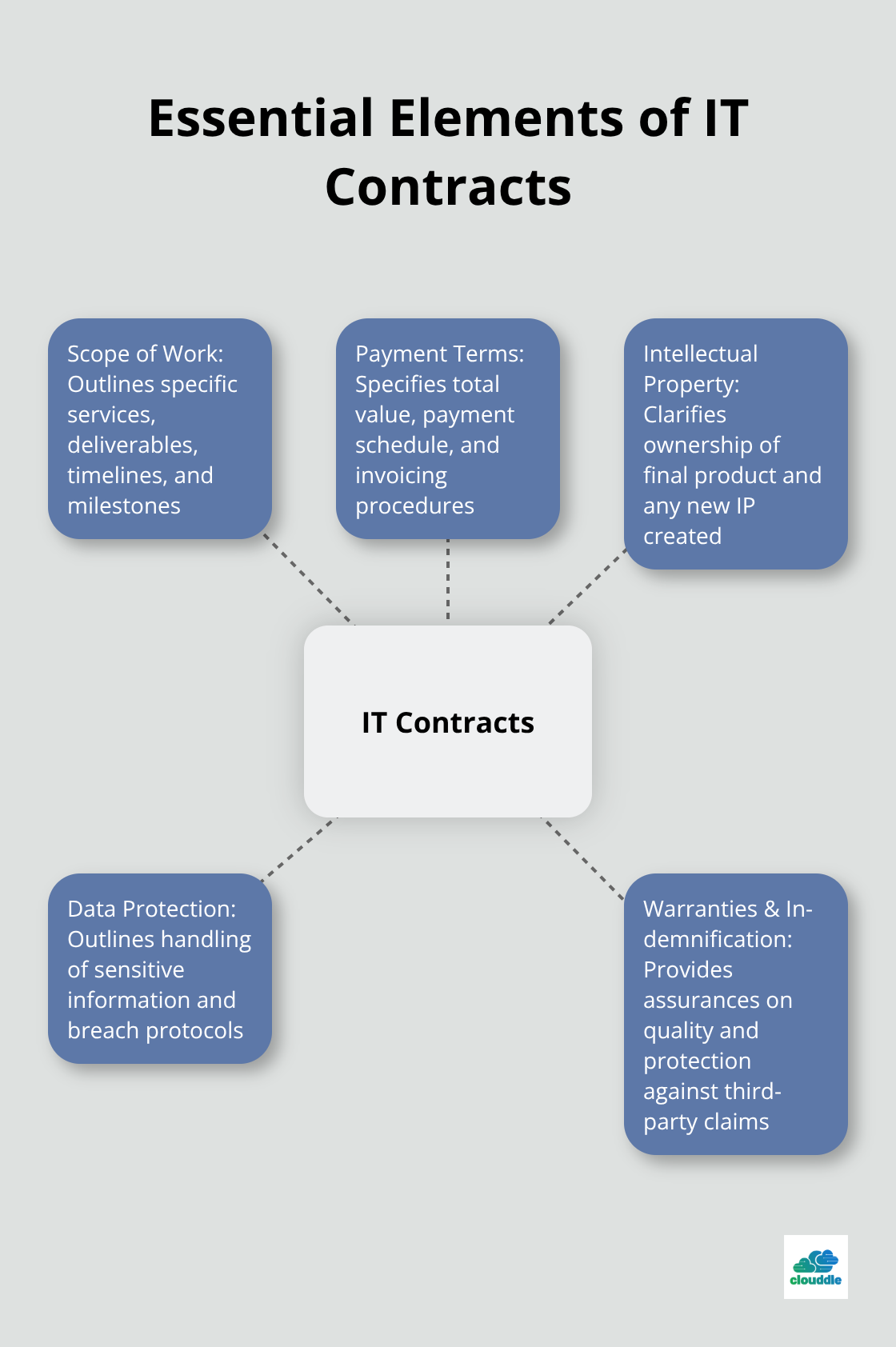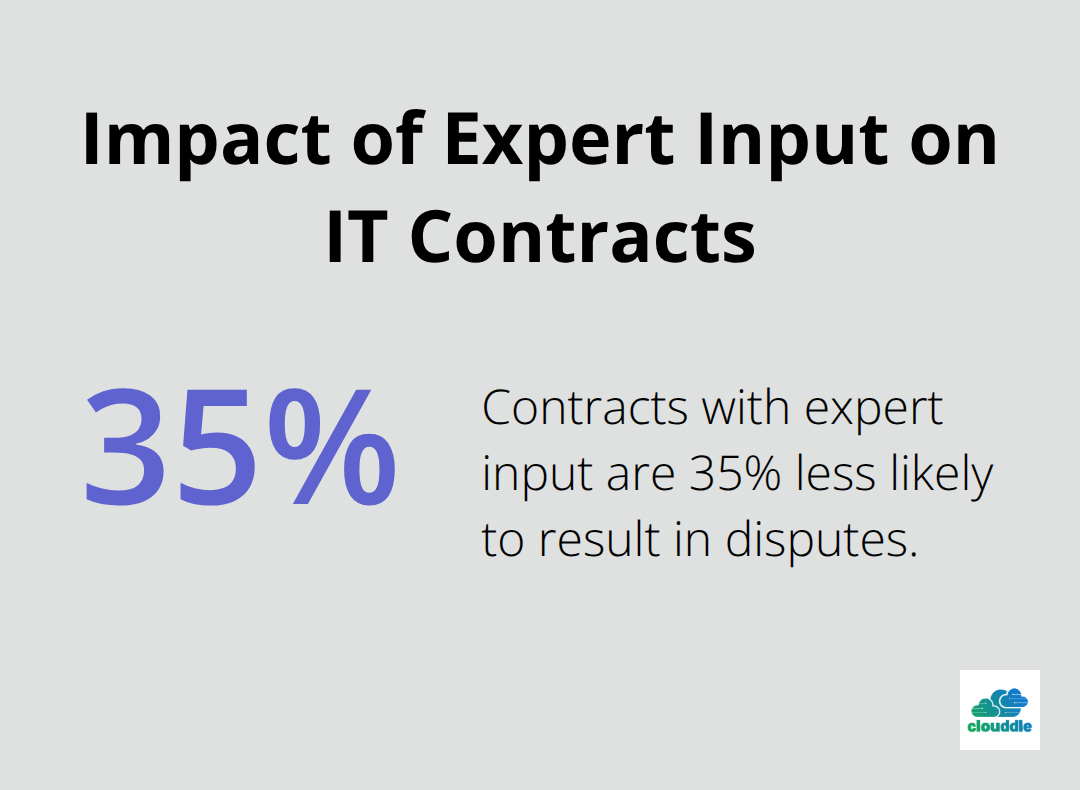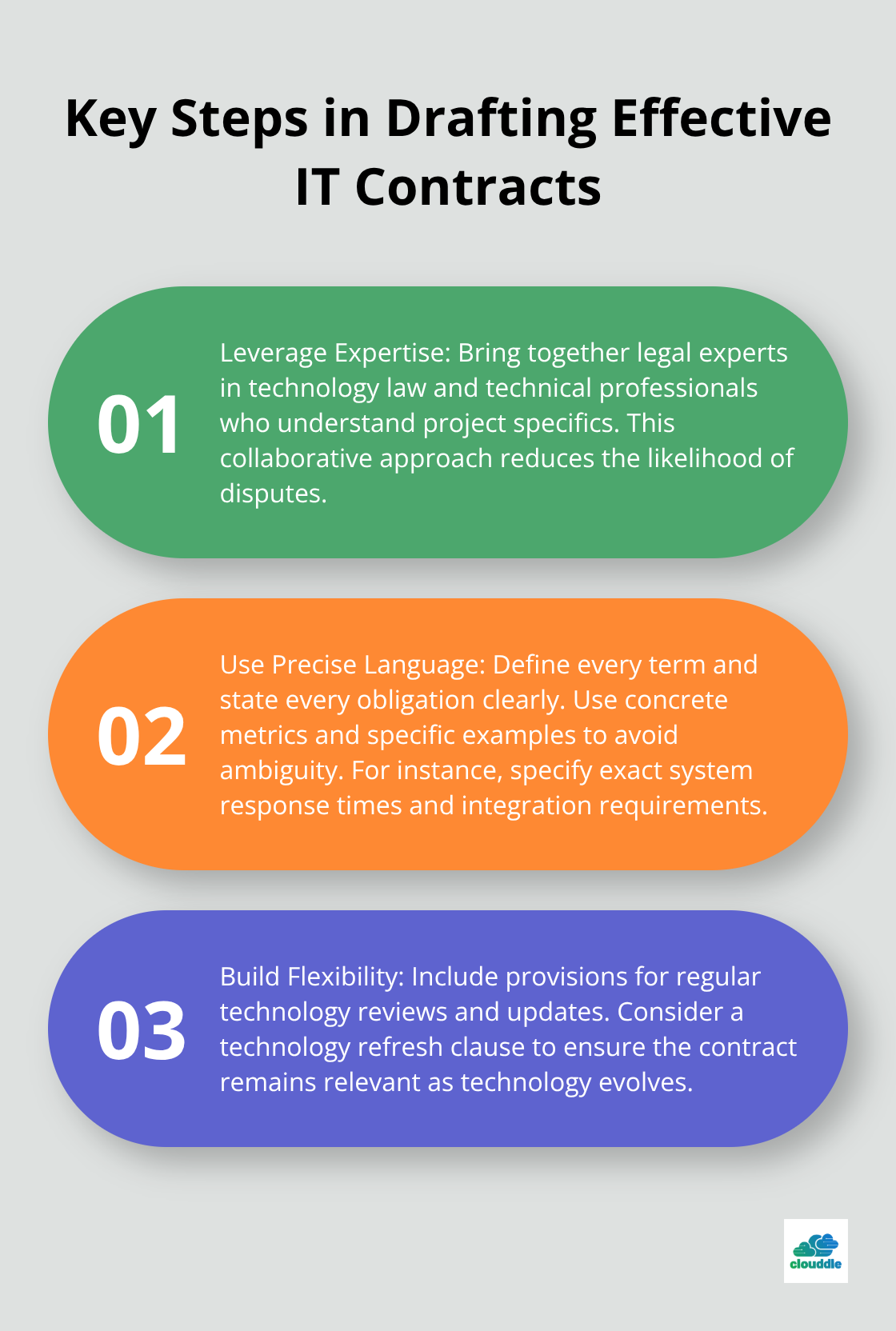IT legal contracts are the backbone of successful technology partnerships. At Clouddle, we’ve seen firsthand how well-crafted agreements can prevent disputes and foster smooth collaborations.
This guide will walk you through the essential components of IT contracts, common pitfalls to avoid, and best practices for drafting legally binding agreements. Whether you’re a tech startup or an established enterprise, understanding these principles is key to protecting your interests and building strong business relationships.

What Are the Essential Elements of IT Contracts?
IT contracts form the foundation of successful technology partnerships. Well-structured agreements can significantly impact the outcome of technology collaborations. This chapter explores the key components that every IT contract should include.
Defining the Scope of Work
The scope of work sets the boundaries of any IT contract. It must outline the specific services or products to be provided, along with expected deliverables. Precision in timelines, milestones, and acceptance criteria is paramount. For instance, instead of a vague “develop a website” description, the contract should specify “develop a responsive e-commerce website with a product catalog, shopping cart, and secure payment gateway, to be completed within 12 weeks.”
Establishing Clear Payment Terms
Payment terms require clarity and precision. The contract should specify the total value, payment schedule, and any conditions for payment. A structured approach might include 30% upfront, 40% at project midpoint, and 30% upon final delivery. Details about invoicing procedures, acceptable payment methods, and consequences for late payments should also be included.
Protecting Intellectual Property
Intellectual property (IP) clauses play a vital role in IT contracts. The agreement must clearly state ownership of the final product, any pre-existing IP, and new IP created during the project. For software development contracts, it’s essential to specify if the client will receive the source code and under what conditions.
Ensuring Data Protection and Confidentiality
With the rise of data privacy regulations (such as GDPR and CCPA), robust data protection clauses have become non-negotiable. The contract should outline how sensitive information will be handled, stored, and protected. Provisions for data breaches must specify notification timelines and responsibilities. An example clause might mandate that any data breach must be reported within 24 hours and that the service provider must assist in breach investigation and mitigation.
Warranties and Indemnification
Warranties provide assurances about the quality and performance of the product or service. The contract should be specific about what is warranted and for how long. For example: “The software will perform according to the agreed specifications for a period of 12 months from the date of final acceptance.”
Indemnification clauses protect against third-party claims. They must clearly state which party is responsible for defending against claims and under what circumstances. For instance, the service provider might indemnify the client against claims of IP infringement related to the delivered software.
These essential elements create the framework for clear, protective, and successful IT contracts. However, the journey to a legally binding agreement doesn’t end here. The next chapter will explore common pitfalls that can undermine even the most carefully crafted IT contracts.
What Are Common IT Contract Pitfalls?
IT contracts require careful consideration due to their complexity. We’ll explore some of the most common pitfalls in IT contracts and how to avoid them.
The Danger of Ambiguous Language
Vague or ambiguous language often leads to disputes in IT contracts. We’ll explore why vague language is a hidden drain on resources, how to build crystal-clear contracts, decode common clauses, and leverage tools to improve contract clarity.
To prevent this, use precise, measurable terms. Instead of “user-friendly,” specify “the system should allow users to complete common tasks within three clicks.” This clarity sets clear expectations for both parties.
Overlooking Change Management
Technology projects often evolve, but many contracts fail to address how changes will be handled. Without proper change management provisions, scope creep can lead to budget overruns and missed deadlines.
Include a detailed change management process in your contract. This should outline how parties request, evaluate, and approve changes. You might specify that all changes require written submission, evaluation for impact on timeline and budget, and approval by designated representatives from both parties before implementation.
Neglecting Service Level Agreements
Service Level Agreements (SLAs) play a vital role in ongoing IT services. SLAs are an integral part of an IT vendor contract. An SLA pulls together information on all the contracted services and their agreed-on expected reliability.
When drafting SLAs, focus on metrics that truly matter to your business. For a cloud hosting service, this might include uptime guarantees (e.g., 99.9% availability), response times for different severity levels of issues, and data recovery time objectives. Also, ensure clear consequences for failing to meet these standards, such as service credits or contract termination rights.
Insufficient Termination Clauses
Termination clauses often become an afterthought, but they protect your interests if things go wrong. Insufficient termination provisions can leave you locked into a failing relationship or vulnerable to sudden service discontinuation.
Your termination clause should cover various scenarios, including breach of contract, insolvency, and termination for convenience. It should also address what happens to data, intellectual property, and ongoing services post-termination. You might specify that upon termination, the provider must return all client data in a usable format within 30 days and continue to provide critical services for a transition period of up to 90 days.
Ignoring Compliance Requirements
Many IT contracts fail to address compliance with relevant laws and regulations. This oversight can lead to legal issues and financial penalties.
Try to include specific clauses that address compliance with relevant regulations (such as GDPR for data protection or HIPAA for healthcare information). The contract should clearly state which party is responsible for ensuring compliance and outline the consequences of non-compliance.
Underestimating System Limitations
One of the most common pitfalls is underestimating the limitations of existing systems. That old software that “gets the job done” might not integrate well with new technologies, leading to unexpected complications and costs.

How to Draft Effective IT Contracts
Leverage Expertise for Comprehensive Contracts
The creation of an effective IT contract requires a team with diverse skills. Bring together legal experts who understand technology law and technical professionals who can articulate project specifics. A study by the International Association for Contract and Commercial Management (IACCM) found that contracts drafted with input from both legal and technical experts are 35% less likely to result in disputes.
Select legal counsel with specific experience in IT law. They should know recent case law and regulations affecting the tech industry. On the technical side, involve project managers and lead developers who can provide detailed insights into the project’s scope and potential challenges.
Use Precise Language for Clarity
Vague language undermines good contracts. Define every term and state every obligation clearly. Instead of “the system will be fast,” specify “the system will have a response time of no more than 200 milliseconds for 95% of user requests under normal load conditions.”
Use concrete metrics wherever possible. For a new CRM system contract, don’t just say it should “integrate with existing systems.” Specify which systems it needs to integrate with and what that integration should look like. For example: “The CRM must import customer data from our existing MySQL database and export sales reports to our Salesforce platform daily.”
Build Flexibility into Agreements
Technology evolves rapidly, so your contract needs to account for this. Include provisions for regular technology reviews and updates. Specify how new features or security patches will be handled. Will they be included in the existing agreement, or will they require additional negotiation?
Consider a technology refresh clause. This could stipulate that after a certain period (say, two years), both parties will review the contract to ensure it still meets current technological standards and business needs. This approach prevents your agreement from becoming obsolete before its term ends.
Flexibility doesn’t mean ambiguity. Even when allowing for future changes, be specific about the process. For example: “Both parties will conduct a joint technology review every six months. Any proposed changes must be submitted in writing and approved by both parties’ designated technical leads within 30 days.”
Include Dispute Resolution Mechanisms
Incorporate clear dispute resolution procedures in your IT contracts. This can include steps for escalation, mediation, and arbitration. Specify timelines for each stage of the resolution process. For instance: “Parties will attempt to resolve disputes through good faith negotiations for 30 days. If unresolved, the dispute will be submitted to mediation within 15 days.”
Address Compliance and Security
IT contracts must address compliance with relevant laws and industry standards. Specify which party is responsible for maintaining compliance (e.g., with GDPR or HIPAA). Include provisions for regular security audits and updates.
Try to detail the security measures required. For example: “The service provider will implement and maintain industry-standard security measures, including (but not limited to) encryption of data in transit and at rest, multi-factor authentication, and regular penetration testing.”

Final Thoughts
IT legal contracts form the foundation of successful technology partnerships. These agreements protect interests, prevent disputes, and foster smooth collaborations in the ever-evolving tech landscape. We at Clouddle have witnessed how well-crafted contracts lead to better outcomes for all parties involved.
Creating effective IT contracts requires precision, foresight, and expertise. Clear language, comprehensive scope definitions, and robust security measures all contribute to a strong agreement. The inclusion of flexible terms allows contracts to adapt to technological advancements without compromising clarity or protection.
Professional guidance often proves invaluable when drafting complex IT legal contracts. Our team at Clouddle specializes in managed IT services and can provide insights into creating agreements that align with your technology needs. We invite you to reach out and explore how we can support your IT contracting process.


